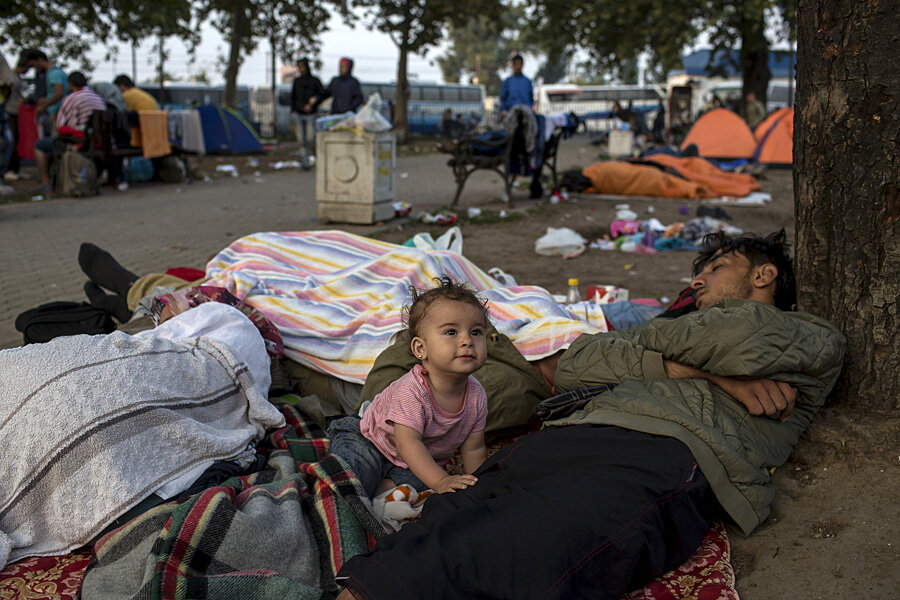Is the Arctic Circle a safer route for Syria refugees?
Loading...
As conflict and violence in Syria, Iraq, and Afghanistan continues, more refugees are seeking asylum in Europe, risking their lives to cross the Mediterranean on overcrowded boats. But some have now found an alternate route, opting to fly to Moscow and cross into Norway via the Arctic Circle.
Located 1,500 miles northeast of Oslo in the town of Kirkenes, the Storskog border post has seen about 150 refugees in the past two months, according to Kirkenes police chief Hans Mollebakken, though Norwegian immigration has processed nearly 1,000 refugees overall this year. Because the border is closed to pedestrians, some migrants arrive by car, while others arrive on bicycle.
The Kirkenes police are on alert, seizing bikes and issuing fines to Russians and Norwegians who have made a business out of driving migrants over the border for a fee, according to the Associated Press. Russian and Norwegian authorities say they are also on alert for human traffickers.
In contrast to the experience of refugees who reach Europe after crossing the Mediterranean, those taking the Arctic route are transported directly to Oslo for processing, a welcome relief for those fleeing from conflict.
The increase in migrants to Norway corresponds with the larger influx of refugees to Europe. Numbers released by European border agency Frontex indicate that 340,000 refugees have reached EU borders between January and July, up from 124,000 last year.
Of those, some 2,500 have died in transit, according to a press briefing published Friday by the UN Refugee Agency, which called upon Europe to "demonstrate responsibility and solidarity" in the face of the refugee emergency.
"Europe cannot be blamed for the migration crisis," said European Council President Donald Tusk, but the EU needs “to alleviate the unbearable human suffering and tragedies that have become everyday news," the Associated Press reports.
Authorities in Austria discovered one such tragedy on Friday. A truck containing the bodies of 71 refugees was found abandoned on the side of a highway near the border with Hungary and Slovakia.
In an Interview with Associated Press, International Organization for Migration Director General William Lacy Swing warned that government policies could lead refugees to dangerous options. "If you deny them, although they have a paid ticket and you don't let them to get on board, you push them right into the hands of smugglers," Swing said, alluding to the migrants found dead in Austria. "So they get into vans and into trucks, and they die."
The good news is that Norway isn’t alone in its efforts to support refugees. Despite the truck incident, trains arriving in Vienna on Monday were met on the platform by hundreds of citizens behind a banner reading “Refugees Welcome – Open Borders.” Most of the refugees, however, disembarked immediately, transferring to trains bound for Germany, reported The New York Times.
Though Finland shares the largest EU border with Russia, Ilkka Herranen from the Finnish Border Guard stated that only a handful of refugees come in along the Russia-Finland border. “Most of the migrants and asylum seekers arrive here from Sweden." Sweden has reduced its estimation of refugees for the year, but not because of border-protection laws. Rather, “long wait times and cumbersome bureaucracy” have discouraged migrants coming via the Mediterranean from traveling so far. Again, most revert to Germany, who raised its estimation from 300,000 to 800,000 refugees expected this year.
In a call for help, Ms. Fleming said, “They [the refugees] are in need of international protection and they are often physically exhausted and psychologically traumatized. UNHCR appeals to all governments involved to provide comprehensive responses and act with humanity and in accordance with their international obligations.”
EU justice and interior ministers are scheduled to meet in Luxembourg on September 14 to discuss the migrant situation and decide on a plan of action.





